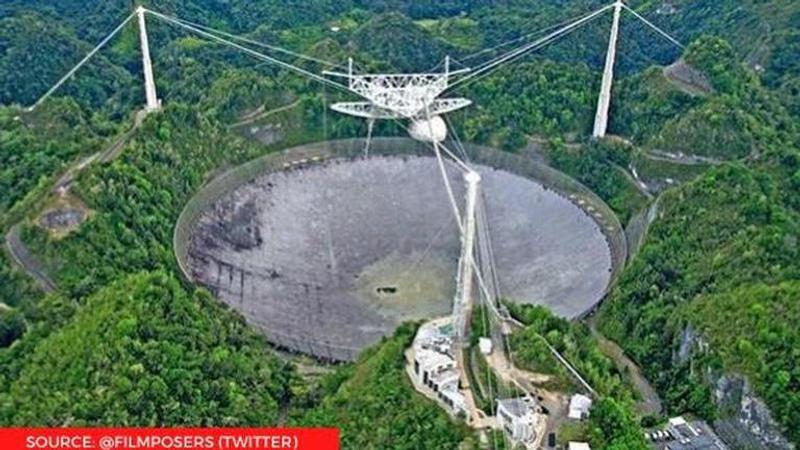Published 13:38 IST, December 2nd 2020
Arecibo Observatory in Puerto Rico collapses after aiding in decades of Space Research
The iconic Arecibo Observatory which was featured in the James Bond film 'GoldenEye' has collapsed in Puerto Rico. Read more details about the collapse.

Advertisement
A gigantic radio telescope in Puerto Rico has collapsed after aiding in decades of astronomical discoveries. The US National Science Foundation (NSF) in a tweet confirmed that the telescope's 900-ton instrument platform fell onto a reflector dish some 450ft (137m) below. The news about the Arecibo Observatory telescope collapse came weeks after officials had announced that the telescope would be dismantled amid safety fears. This decision was taken as a result of the damage that its support system had sustained. Read on to know more about the incident.
Arecibo Observatory telescope collapses in Puerto Rico
The Arecibo Observatory telescope was one of the largest in the world. It was also a key scientific resource for radio astronomers for 57 years. In fact, it was so popular that it was featured as the backdrop for a scene in the James Bond film GoldenEye. It has made sneaky guest appearances in many other Hollywood movies. The NSF took to its Twitter to inform that fortunately, there were no reports of injuries following the collapse.
The instrument platform of the 305m telescope at Arecibo Observatory in Puerto Rico fell overnight. No injuries were reported. NSF is working with stakeholders to assess the situation. Our top priority is maintaining safety. NSF will release more details when they are confirmed. pic.twitter.com/Xjbb9hPUgD
— National Science Foundation (@NSF) December 1, 2020
What exactly happened at the Arecibo Observatory telescope collapse?
On its official website, the NSF stated that the telescope had collapsed at about 07:55 local time (11:55 GMT) on Tuesday, December 1, "resulting in damage to the dish and surrounding facilities”. The Arecibo Observatory consisted of a 1,000ft-wide radio dish with an instrument platform hanging 450ft above. The platform was suspended by cables connected to three towers.
Additional details regarding the collapse at the Arecibo Observatory’s 305-meter telescope are available now at NSF's site: https://t.co/dCYLolC22L
— National Science Foundation (@NSF) December 1, 2020
Engineers are on-site. Top priorities are maintaining safety at the site and assessing damage. pic.twitter.com/9mqnBx3dcU
The NSF has informed that an investigation into the platform's fall was ongoing. Initial findings indicated that the top section of all three of the telescope's support towers has chipped off. As the 900-ton instrument platform fell, the telescope's support cables also dropped. Further preliminary assessments indicated the observatory's learning centre sustained significant damage from falling cables. However, the telescopes fall was not entirely a surprise as two cables had broken since August. This had damaged the structure and forced the officials to shut down the observatory.
The Arecibo Observatory was a location in two recognizable films: GoldenEye (1995) and Contact (1997). pic.twitter.com/I5XtAHUZ5c
— Film Posers™️ (@FilmPosers) December 1, 2020
Why wasn’t the observatory repaired for so long?
According to a report in the BBC, a review last month had found that the telescope was at risk of catastrophic collapse. However, the altitudinal structure could not be repaired without putting the construction workers at potentially deadly risk. Jonathan Friedman, who worked for 26 years as a senior research associate at the Arecibo observatory and still lives near it, revealed to the Associated Press news agency that the observatory’s fall sounded like a rumble. He also stated that it was a very deep, terrible feeling. At the moment, an Arecibo collapse video is not available on the internet.
The telescope was built in the early 1960s, with the motive of studying the ionised upper part of Earth's atmosphere, the ionosphere. But it was soon being used as an all-purpose radio observatory. One of the landmark Arecibo Observatory discoveries was when it provided the first solid evidence of neutron star. The telescope also helped to identify the first example of a binary pulsar, which are two magnetised neutron stars orbiting around a common centre of mass. This earned its discoverers the Nobel Prize in Physics.
Updated 13:38 IST, December 2nd 2020



